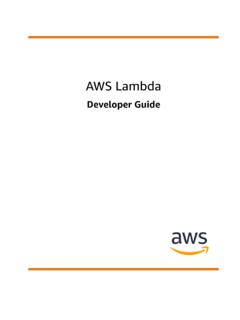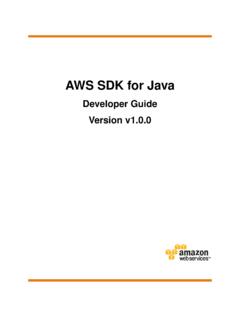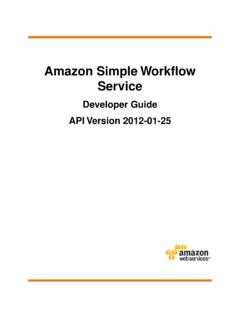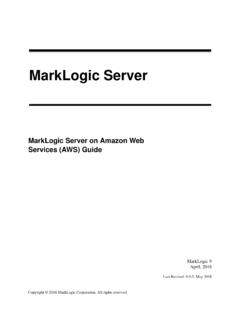Transcription of EFS-to-EFS Backup Solution - Amazon S3
1 Copyright (c) 2019 by , Inc. or its affiliates. EFS-to-EFS Backup Solution is licensed under the terms of the Amazon Software License available at EFS-to-EFS Backup Solution AWS Implementation Guide Lalit Grover Garvit Singh Darryl Osborne October 2017 Last updated: February 2019 (see revisions) Amazon Web Services EFS-to-EFS Backup Solution February 2019 Page 2 of 19 Contents Overview .. 3 Cost .. 3 Architecture 4 Design Considerations .. 5 Incremental Backups .. 5 Consistent Backups .. 6 Sizing and Capacity .. 6 Burst 6 Granular Backups .. 7 Encryption .. 7 Visualization .. 7 Cross-Account Backups .. 7 Regional Deployment .. 7 AWS CloudFormation Template .. 8 Automated Deployment .. 8 Prerequisites .. 8 Launch the Stack .. 9 Restore a Backup .. 11 Security .. 13 Security Group .. 13 Additional Resources .. 13 Appendix A: Amazon EC2 Instance Size .. 13 Appendix B: Logs ..14 Appendix C: VPC/Subnet Configuration .. 15 Appendix D: Large File Systems .. 15 Appendix E: Collection of Anonymous Data.
2 16 Source Code ..19 Amazon Web Services EFS-to-EFS Backup Solution February 2019 Page 3 of 19 Document Revisions ..19 About This Guide This implementation guide discusses architectural considerations and configuration steps for deploying the EFS-to-EFS Backup Solution on the Amazon Web Services (AWS) Cloud. It includes links to an AWS CloudFormation template that launches, configures, and runs the AWS services required to deploy this Solution using AWS best practices for security and availability. The guide is intended for IT infrastructure architects, administrators, and DevOps professionals who have practical experience architecting on the AWS Cloud. Overview Note: AWS Backup , a fully managed Backup service, now enables you to centrally manage backups for Amazon EFS file systems. We recommend that you evaluate AWS Backup for your specific use case before you use this Solution . Many Amazon Web Services (AWS) customers who use Amazon Elastic File System ( Amazon EFS), a highly available and durable file storage service, choose to implement a Backup Solution to be able to recover from unintended changes or deletions to their file systems.
3 This guide provides infrastructure and configuration information for planning and deploying an EFS-to-EFS Backup Solution that automatically copies data from your Amazon EFS file system (the source file system) to another Amazon EFS file system (the Backup file system). The EFS-to-EFS Backup Solution automatically deploys the necessary AWS services, including Amazon CloudWatch and aws lambda , to create automated, incremental backups of Amazon EFS file systems on a customer-defined schedule. The Solution is simple to configure and makes it easier to create and restore backups for data recovery and protection. You can use this Solution to create backups for your file systems on a daily, weekly, or monthly basis and retain these backups as necessary to meet your business requirements. Cost You are responsible for the cost of the AWS services used while running this Solution . The total cost of running this Solution depends on the interval of the aws lambda function and the amount of storage your Backup consumes.
4 We recommend that you carefully consider your Backup frequency and retention settings to avoid incurring unnecessary charges. Amazon Web Services EFS-to-EFS Backup Solution February 2019 Page 4 of 19 As of the date of publication, the total cost for running this Solution with the default settings in the US East (N. Virginia) Region is approximately $ per month plus variable data storage and Amazon Simple Notification Service ( Amazon SNS) charges. The cost estimate assumes the following scenario: The Solution creates a daily Backup and an Amazon CloudWatch metrics dashboard The Solution makes four aws lambda executions per Backup process The Solution uses five Amazon DynamoDB read capacity units and five write capacity units per month The Amazon Elastic Compute Cloud ( Amazon EC2) instance runs for three hours daily The cost to restore a Backup depends on how long the restore Amazon EC2 instance runs (see Restore a Backup ) and the number of Amazon SNS notifications the Solution publishes.
5 Prices are subject to change. For full details, see the pricing webpage for each AWS service you will be using in this Solution . Architecture Overview Deploying this Solution builds the following environment in the AWS Cloud. Figure 1: EFS-to-EFS Backup Solution architecture The AWS CloudFormation template deploys two Amazon CloudWatch events, an aws lambda function, an Amazon DynamoDB table, an Amazon Simple Notification Service ( Amazon SNS) topic, and an Amazon Simple Storage Service ( Amazon S3) bucket. It also Amazon Web Services EFS-to-EFS Backup Solution February 2019 Page 5 of 19 deploys an Amazon EC2 Auto Scaling group that launches and terminates an Amazon Elastic Compute Cloud ( Amazon EC2) instance when a CloudWatch event occurs, and a Backup Amazon Elastic File System ( Amazon EFS) file system in your existing Amazon Virtual Private Cloud ( Amazon VPC). One Amazon CloudWatch event runs at an interval you specify during initial configuration.
6 This event invokes the Solution s orchestrator aws lambda function, which modifies the desired capacity of the Auto Scaling group to launch the Amazon EC2 instance, creates an ID for the Backup , and stores details about the Backup Amazon EFS file system in a DynamoDB table. The orchestrator function also creates a second CloudWatch event that stops the Backup process if the Backup process does not finish before a customer-defined amount of time (the Backup window) has passed. During boot, the Amazon EC2 instance mounts the source and Backup Amazon EFS file systems and initiates the Backup . When the Backup process completes, the instance updates the Backup activity details in the DynamoDB table, sends logs to the Amazon S3 bucket, and modifies the desired capacity of the Auto Scaling group to terminate the instance. If the instance cannot update the DynamoDB table, Amazon SNS sends a notification to subscribed email addresses. If the Backup window expires before the Backup process completes, the second CloudWatch event invokes the orchestrator function to update the desired capacity of the Auto Scaling group to terminate the instance.
7 If the Backup is unsuccessful, Amazon SNS sends a notification to subscribed email addresses. You can also choose to be notified if the Backup is successful. Design Considerations Incremental Backups The EFS-to-EFS Backup Solution captures the state of an Amazon Elastic File System ( Amazon EFS) file system at a point in time. If you specify a Backup window long enough to copy your entire file system, the Solution will copy the entire file system or the entire subdirectory the first time it creates a Backup . When the Solution creates future backups for that file system, it copies only the files and directories that have changed, or been added or removed since the last Backup . We recommend that you launch the Solution for the first time with a large instance type, and a Backup window large enough to copy your entire file system. After the first Backup completes, update the running stack with a smaller instance type and Backup window to reduce costs and save burst credits.
8 Amazon Web Services EFS-to-EFS Backup Solution February 2019 Page 6 of 19 Consistent Backups This Solution uses fpsync, a tool that synchronizes directories in parallel using fpart (sorts and packs files into partitions) and rsync (a file-copying tool), to copy the source file system to the Backup file system. Note that this Solution might exclude any data written while fpsync or the Backup process are running. To ensure consistent backups, we recommend that you do not perform writes on the source Amazon EFS file system for the duration of the Backup process. Note that after the Solution creates the initial Backup , future backups are incremental and will take less time to complete. Sizing and Capacity This Solution uses a single Amazon Elastic Compute Cloud ( Amazon EC2) instance ( ). The maximum throughput you can drive per NFS client on an Amazon EC2 instance is 250 MB/s. All Amazon EFS file systems, regardless of size, can burst to 100 MiB/s of throughput, and those over 1 TiB large can burst to 100 MiB/s per TiB of data stored in the file system.
9 The size of the file system determines the portion of time a file system can burst. Amazon EFS uses a credit system to determine when file systems can burst. For more information about how the credit system works, see Amazon EFS Performance in the Amazon EFS User Guide. Large file systems might cause this Solution to hit the Amazon EC2 instance throughput limit. Customers who want to back up large file systems can launch multiple deployments of the Solution with different source prefixes that point to different locations in the source file system. For example, a customer with a large Amazon EFS file system that contains a home directory and an appdata directory can deploy two Solution stacks: one that points to the home directory (<efs-mount-point>:/home) and one that points to the appdata directory (<efs-mount-point>:/appdata). Customers can also launch multiple deployments of the Solution to back up multiple Amazon EFS file systems in an AWS Region.
10 We recommend that you use a rigorous performance testing and optimization process to choose the right instance type for your use case. For more information, see Appendix A. File systems with a large number of files (around one million or more) can also cause the Backup process to fail. For more information about file systems with a large number of files, see Appendix D. Burst Credits This Solution will consume burst credits while creating backups, which could impact your production workload. We recommend that you verify that you have sufficient burst credits available before you start the Backup process. You can also change the Solution s default Amazon Web Services EFS-to-EFS Backup Solution February 2019 Page 7 of 19 Amazon EC2 instance type to change how the Solution consumes burst credits. For more information, see Appendix A. Granular Backups The EFS-to-EFS Backup Solution enables customers to specify any valid directory from their source file system.



















